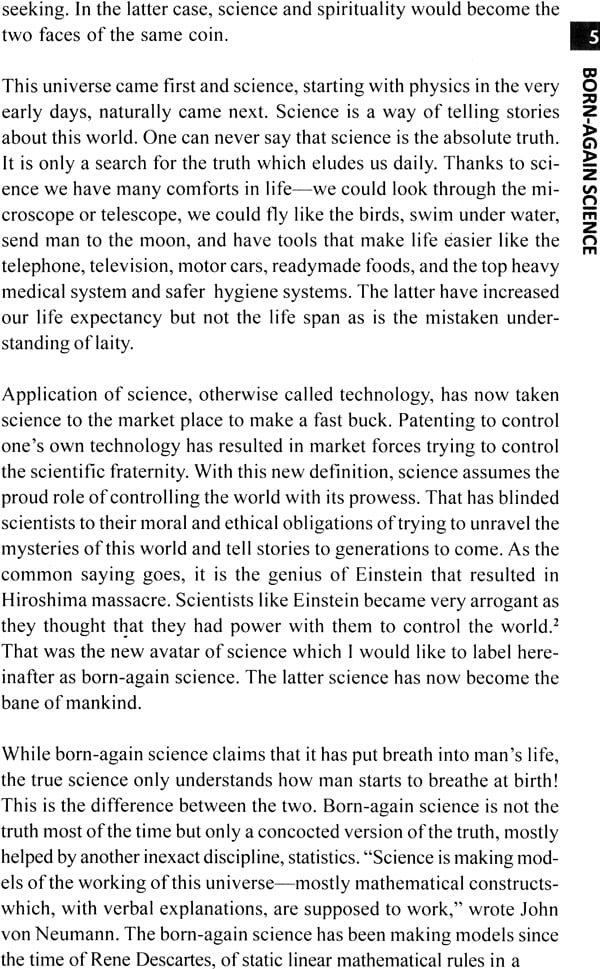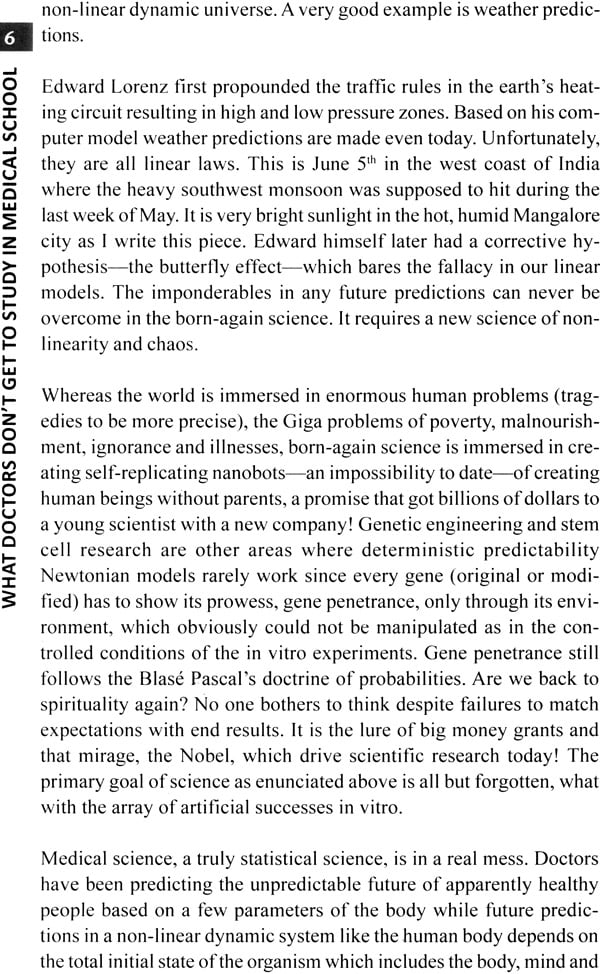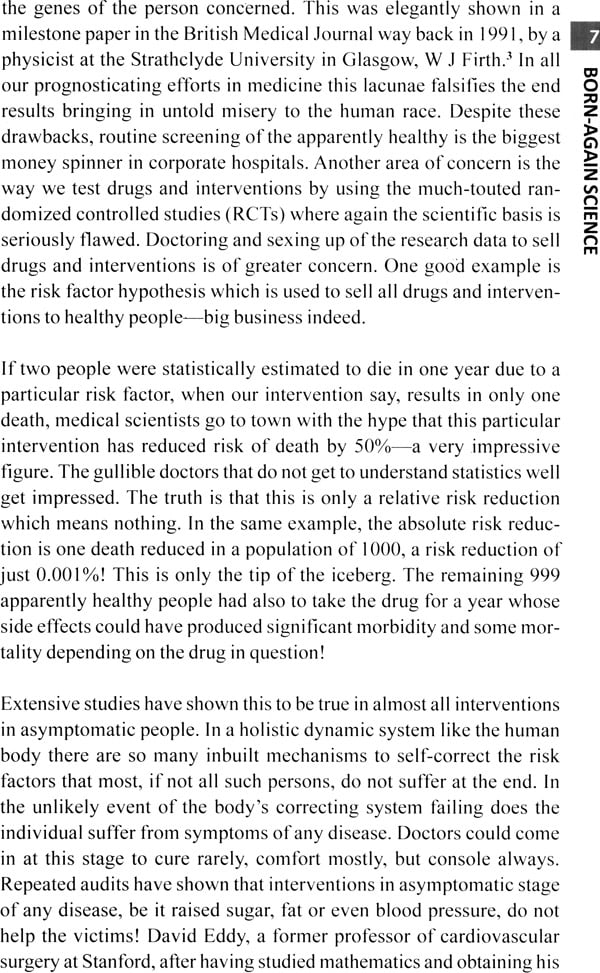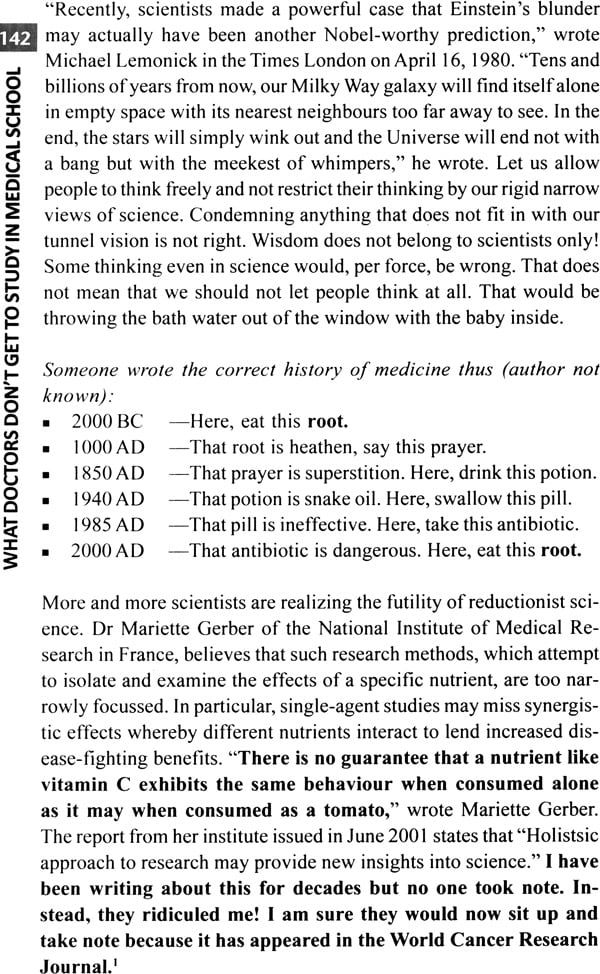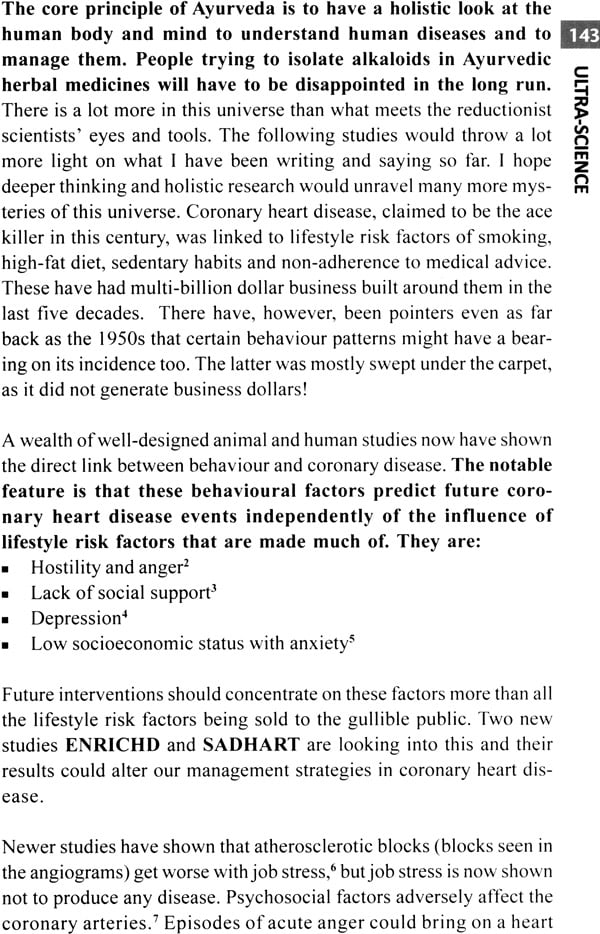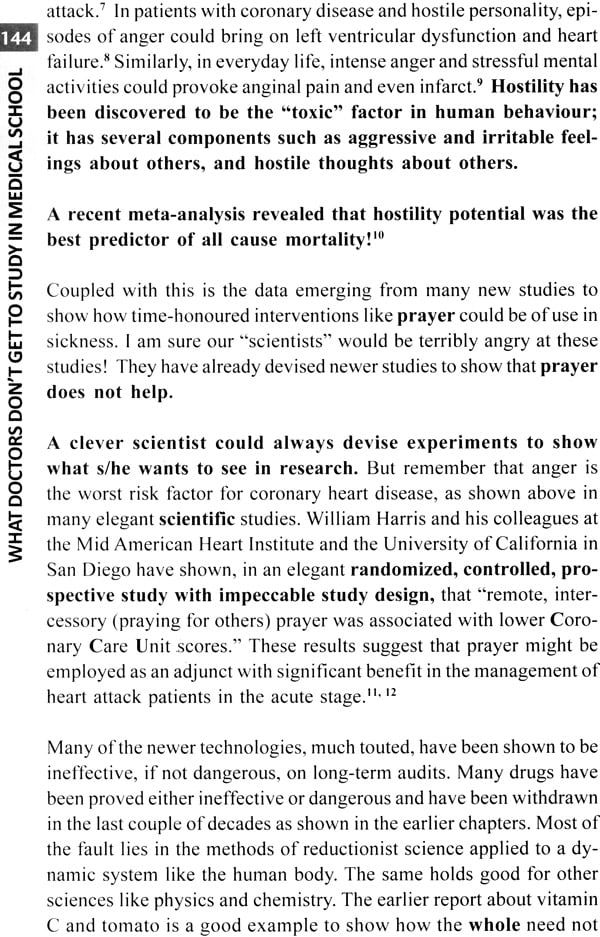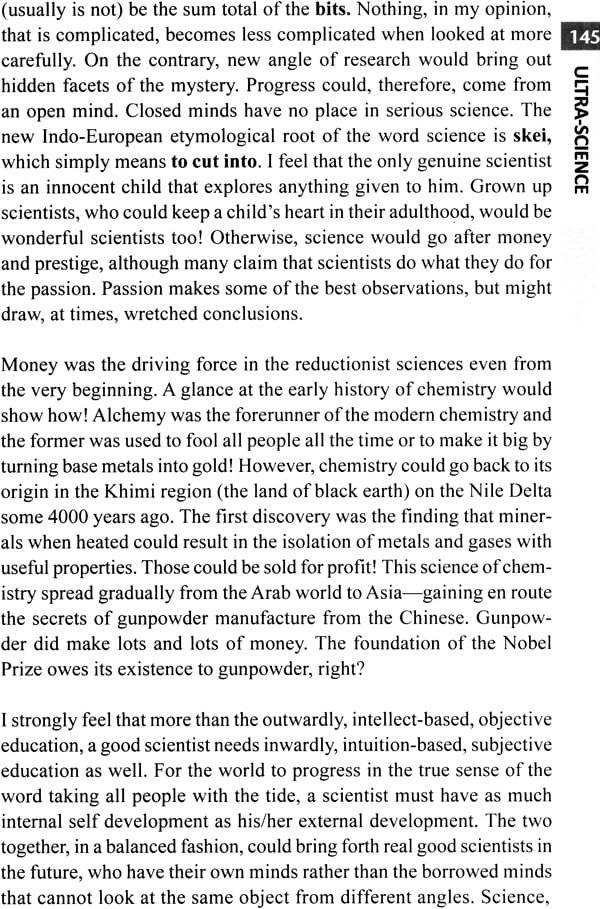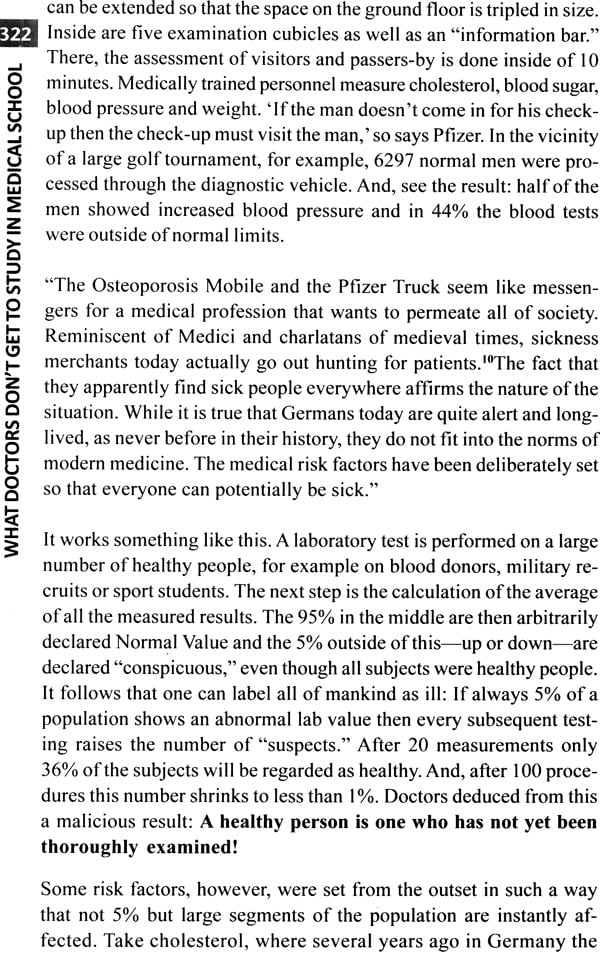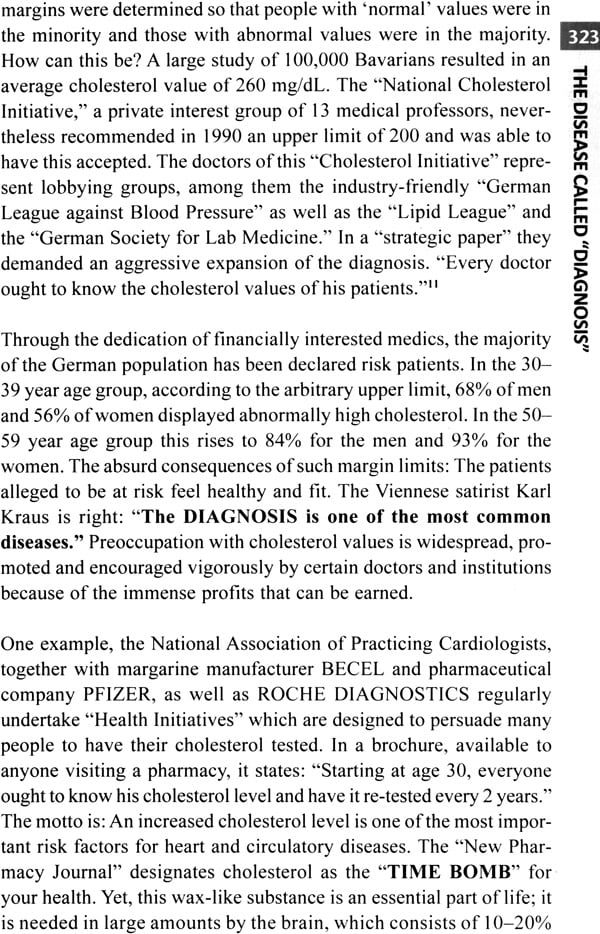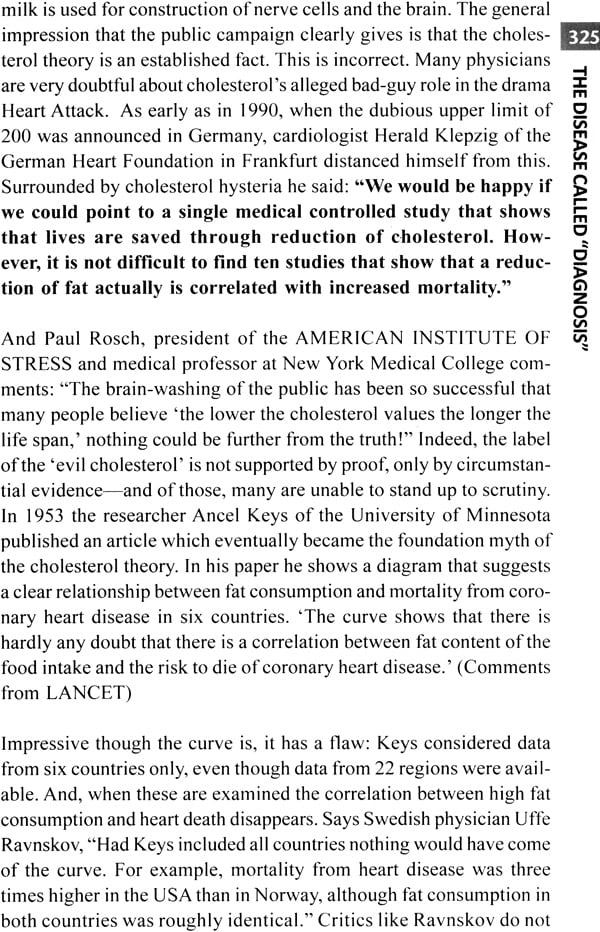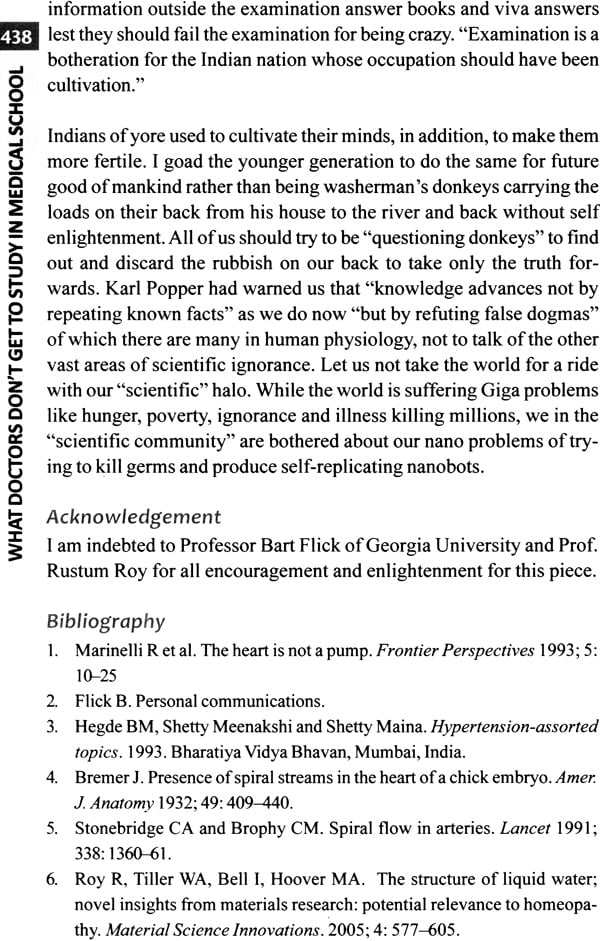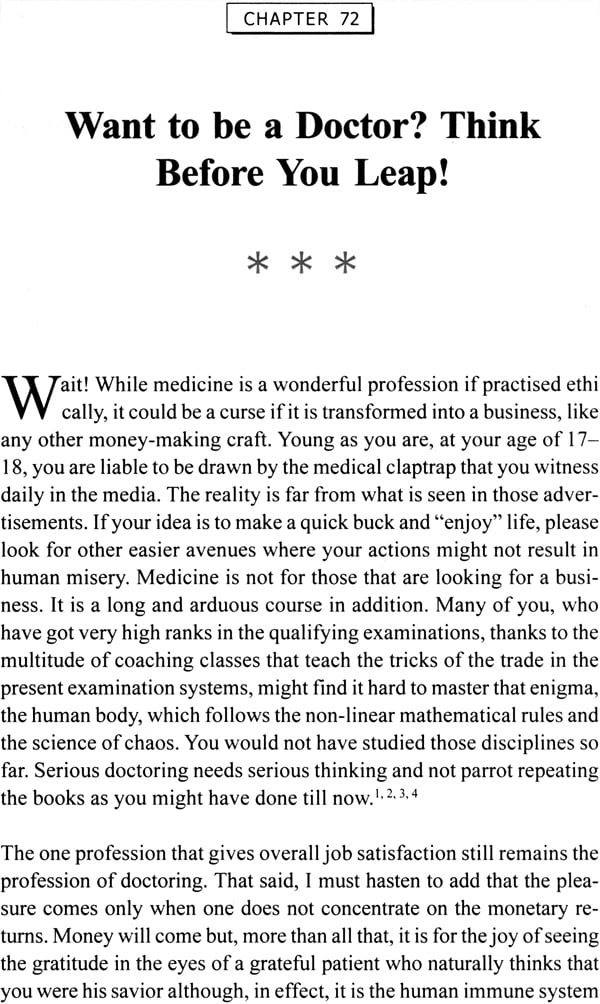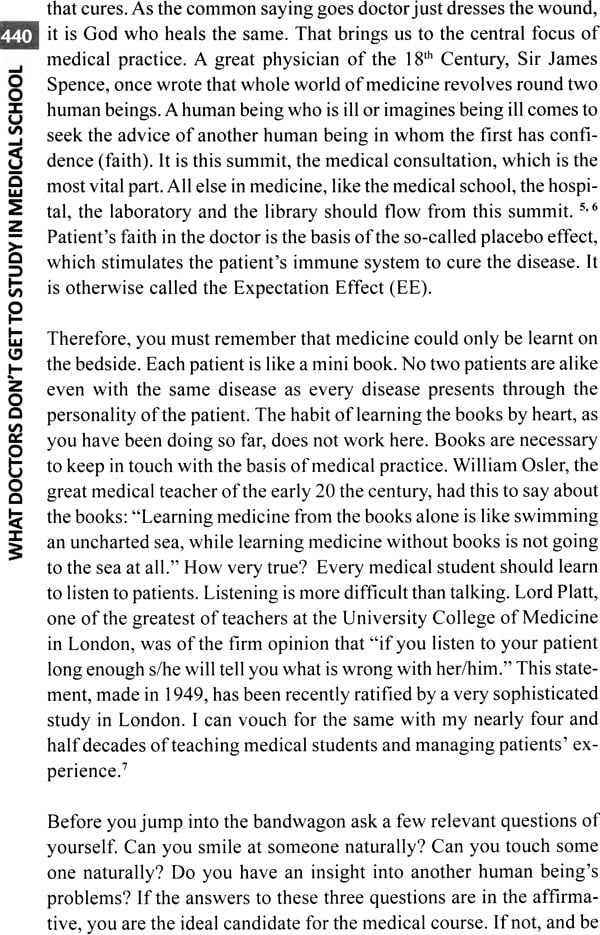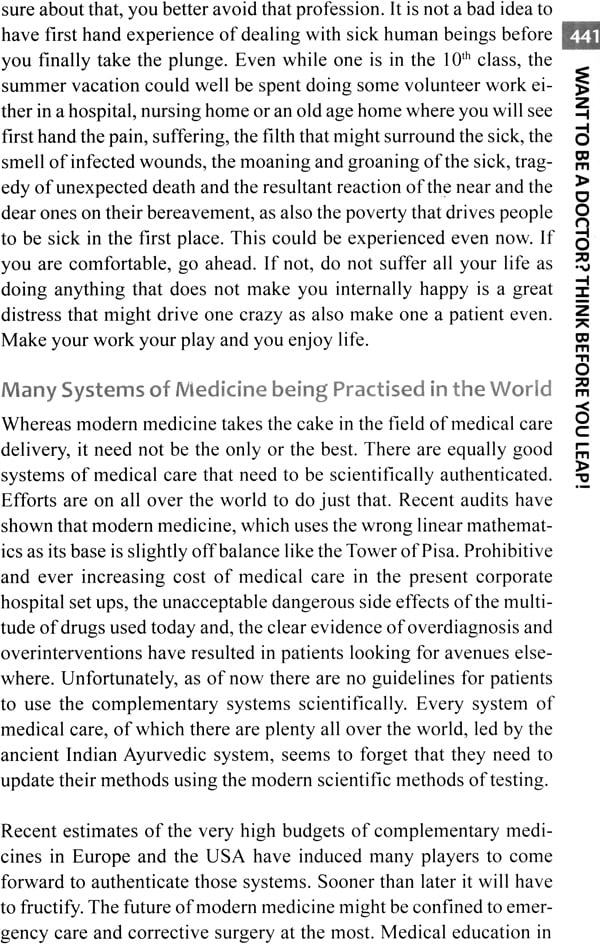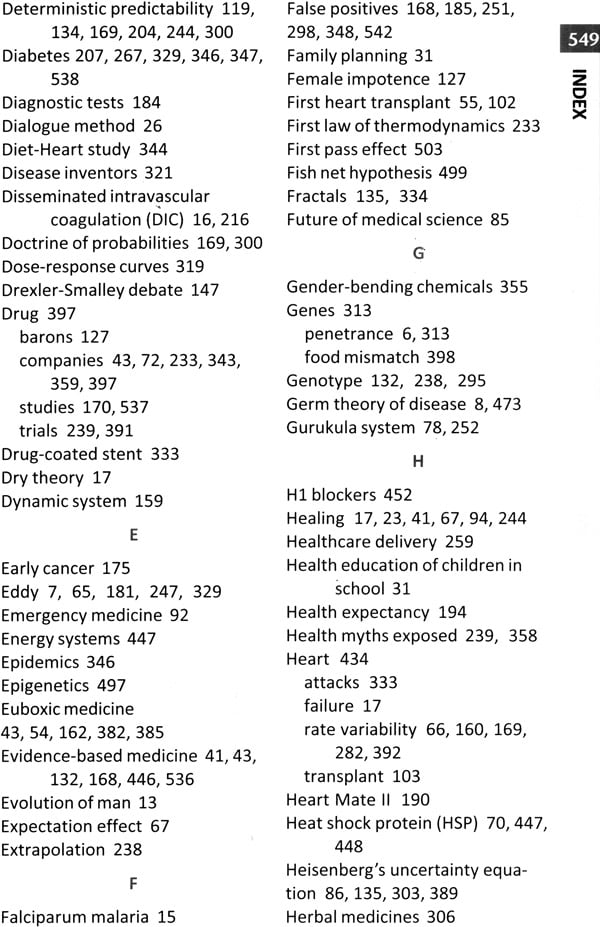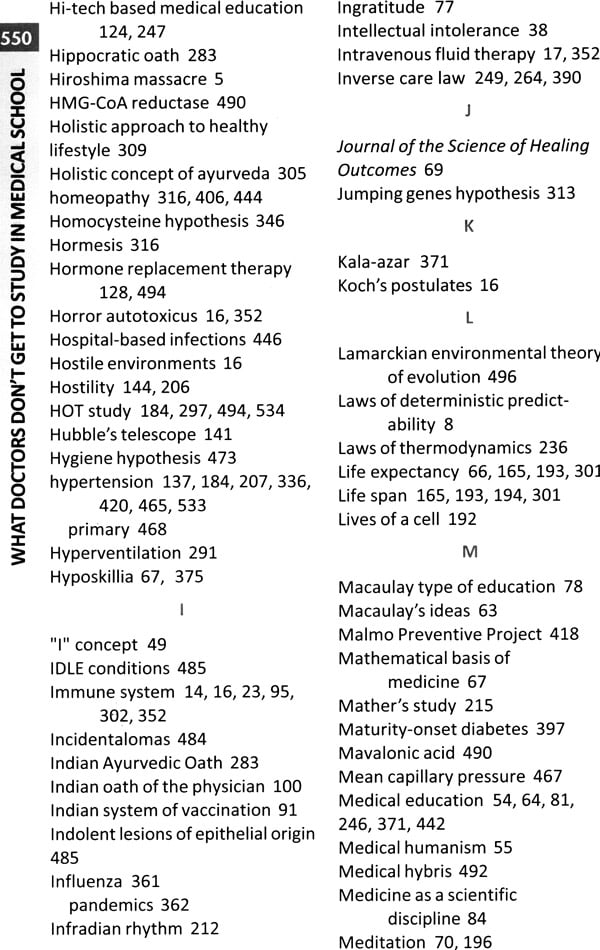
What Doctors Don't Get to Study in Medical School
Book Specification
| Item Code: | NAH909 |
| Author: | BM Hegde |
| Publisher: | Paras Medical Publisher |
| Language: | English |
| Edition: | 2019 |
| ISBN: | 9788181914194 |
| Pages: | 572 |
| Cover: | Paperback |
| Other Details | 8.5 inch X 5.5 inch |
| Weight | 610 gm |
Book Description
There are several compelling reasons why different groups among the millions of users and friends of Whole Person Healing (often misleadingly called by the US Government "Complementary and Alternative Medicine," (CAM), should read this book. First, let me paraphrase Hippocrates (who better on a book/or medical students?): "It is more important to know the author than the book that she/he has written." In the original it said: "It is more important to know the person than the disease the person has." That is still true.
I have known the author, Dr BM Hegde, for less than a year, starting when both he and I spoke at a historic meeting in the great hall of the Indian National Science Academy (INSA) in October 2004. This meeting, which I helped initiate, was convened by the Director General of the CSIR (Dr RA Mashelkar) and the President of INSA (Dr MS Valiathan). It was on a subject which could never have been allowed in the corresponding venue by the similar executives in any other country in the world. The focus was on the "Science of Traditional Healing." The conveners and I were speakers there, but I was most impressed by the content and the style of the talk by Dr Hegde. What was impressive in that context, as it is in this book, is that he spoke from the position of leadership in the hardcore western medicine world, and he spoke from his heart and head at the same time. He is a senior, learned practitioner and researcher, and administrator in that world of allopathic medicine. Hence what he says in constructive criticism of the world of current (allopathic) medical practice, carries weight which those outside the field, like myself, cannot aspire to. Moreover, what drew me to him was his forthright style: he called spades, "spades"; and gave the well-established figures on the failures of the hi-tech medical world with gusto and authority.
Every foreword should inform the reader about what kind of audience would most benefit from this book. Although he says this cannot be a "textbook," clearly the author intends it for the students and graduates of the world of academic medicine (mainly allopathic). For them, I believe it should be required reading, but it will certainly be part of the important and formative reading we all do outside the requirements for a degree. Here, laid out concisely, are all the rather well-established potholes and pitfalls in current medical thinking and practice. The exceptional value of this work by Dr Hegde is that solid data have been clearly pulled out and catalogued from the literature and put into punchy, attention-getting form.
In his chapter on "Need-based education" his sound comments on philosophy, pedagogy, even examinations of various kinds, bring out his wisdom born of long experience as Department Head and Dean and Vice-Chancellor.
But Dr Hegde's work will have equal value to the vast numbers of practitioners of Whole Person Healing-acupuncturists, chiropractors, naturopaths, Reiki masters, electromagnetic device manufacturers, etc. Why? Because they will see that the claims of much of high-tech medicine are riddled with doubt compared to the glossy advertising, and even papers, whether in NEJM, BMJ or in the local newspaper advertisements for Nexium or Viagra. His critiques of the absurd overreliance on technology of dial-watching instead of pulse taking, of the profound role of money instead of caring, enlighten us as to how they are distorting the healing vector in deep and profound ways. His positive exposition of the role of rhythm and holism is an appropriate counterweight.
Let me comment on his style from the viewpoint of a physical-chemist-materials scientist. What I salute is his utilization of relevant data and facts with little attention to explanations, mechanisms and theories. In this, he follows the call of Aristotle, writing in Nicomachean Ethics:
"Nor again must we in all matters alike demand an explanation of the reason why things are what they are; in some ca e it is enough if the fact that they are so, satisfactorily established. This is the case with first principles; and the fact is the primary thing-it is a first principle. "
Medical science has overrun its headlights-following the arcane parts of physics. It aims for explanation, theories, elegance, what it lacks in data. Instead of electron-micrographs, we see "cartoons" of alleged structures. After a headline says "New drug shows promise of cure for XYX," the demurrer phrase about side effects repeated ad nauseam is always in small print or well hidden. Dr Hegde reaches far and wide for data. The book is loaded with excellent and valuable references for all honest medical scientists who seek to improve their fields instead of merely mining it to make a very good living.
The key ideas are often leaked out to the reader very effectively in the chapter headings and highlighted quotes at the beginning. For example, to introduce "Health Care Delivery" (in India) he opens with the quote,
"The thinking that doctors and hospitals are needed to keep a society healthy is plain rubbish."
This profound truth has many parents. No one has ever challenged it, but it is uniformly ignored. My Penn State colleague and brilliant social philosopher, Ivan Illich, modern pioneer of this viewpoint, author of Medical Nemesis (1975), told many similar tales, and gave other data like those cited in this book, in this case by a leading medical professional with a plethora of data. Indeed, comparing the data between Illich and Hegde, one can see that in the 30 years between them, things have gotten even worse. Hegde correctly uses the pitiful state of US Healthcare as revealed in absolutely unchallenged data such as in the recent papers and books of Starfield and Angell to make his point that India should "not follow the footsteps of USA." I go much further. The USA healthcare system is a terminal patient in the "ICU." It is the existence theorem for the proof of the proposition that for profit healthcare is an oxymoron. Profiting from the pain of others sounds intrinsically contradictory, as it has always been. The healing intention is an agapeic vector. India has the potential, using its own healing and social traditions, combined with its own hi-tech abilities to design a multi-level healthcare system, which distributes the benefits in a radically different but sustainable ratio than in the US model. Good primary care for all (free), modest secondary care for many (partially subsidized to retain the element of taking responsibility for one's own health), tertiary care for the few (largely out of pocket). Hegde's approaches are developed in depth in his chapter on the "Future Medicare System," which is wise counsel for all of us thinking about this unavoidable topic.
I salute the author also for not falling into the trap of fashionable pseudoscience, repeating the mantras or "halowords" like "quantum" and "consciousness" several times on the page. His short introduction to chaos theory is relevant; and intelligible. But he "stays on message": healing humans.
He introduces the place of, and the relevance and importance of, "CAM," which we have now made more accurate as "WPH," with interesting anecdotes and references to India's own great healing tradition of Ayurveda-on which he has of course written elsewhere in depth.
I salute him also for dealing with the fundamentals of a health care not a disease management system, with "health expectancy" not life expectancy. In a talk he gave in Washington in April 2005, Dr Hegde's critique of health screening were echoed in the plenary paper by the esteemed Dr Larry Dossey, who gave the latest statistics on the dangers of screening and regular testing of populations.
Let me end this foreword with a comment on what is demonstrated by the author's style. First, his "catholicity" and his scholarship-he quotes equally from Sanskrit texts, and all the Greek and European philosophers and, of course, healers across 3000 years. But most importantly he does it with certain panache, a fearless and zesty style. That is the characteristic most missing in modem science and medicine today. I would say: Read this book to get a taste of the quality of "enthusiasm" (the etymology of "enthusiasm" links it to "en-theos," through God [the Spirit)) from a brilliant and committed author, if for no other reason!
Since I wrote the Foreword to the First Edition my appreciation for the quality and work of Prof Hegde has deepened and expanded. All the details on the content of this book remain the same. It is an absolutely necessary introduction for all informed citizens of any country to the real state of the "Illness as a major profit producing industry," which now has infested the whole "modern world."
In the last few years, Dr Hegde and I have worked together to advance the cause of human healing in various ways: a variety of meetings, where we both spoke; research on shared topics; the starting of a pioneering peer-reviewed journal for Whole Person Healing (WPH) practitioners. "Whole Person Healing" is not only about "medicines," pills, etc at all. It is not about the body-only, self-imposed prison; it deals with "Whole Persons," which include intimate interpenetrating mixtures of bodies, minds and spirits (which make up every human being), which are healed via any of the same three vectors: via body, mind or spirit.
We have worked to. clean up the language used in the health world. Thus, ALL terms using medicine, such as Alternative Medicine, Complementary and Alternative Medicine, etc, should be abandoned. So many healing vectors do not use any "medicines" at all. We abandoned the egregiously misleading term "evidence-based" medicine, when the best that a RCT "randomly controlled trial" can claim is exactly the opposite. It is, accurately, a "Statistically obtained result" trial. Indeed in so many WPH practices, it is the conventional medical world that refuses to accept the scientific evidence, of repeatable cause and effect, whether in Chinese Qi Gong or Indian Ayurvedic practices; of the dramatic evidence of spiritual healings. We have substituted the simple English term "Expectation Effect" to replace the absurd meaningless (because it means different things to different audiences) term "Placebo." If either doctor or patient "expects" "wants" something to happen, there is now overwhelming evidence that that makes it much more likely to happen. And the likelihood increases with both the intensity of the desire, and the depth of emotional, personal connection between the parties involved. It is interesting to note that in Feb 2009 the US National Academy of Sciences hosted its own US Institute of Medicine's "Summit on Integrative Medicine [SIC]," which clearly put its stamp of acceptance on this broader approach to health via WPH and prevention and wellness; and by the end of the meeting the audience moved the meeting towards these very much clearer terminologies.
Dr Hegde and I have also worked together at the cutting edge of modern healing science. In one area, using essentially pure water as a major vector - with startling success - and we have studied new devices drawing on Materials Science & Physics, instead of the single focus on "Biochemistry" of modem medicine (visit www friends of health. org for details).
Dr Hegde also makes the strong case against ceding individual, thoroughly and intimately informed, judgments about ourselves to the ill-famed "specialists" who for whatever reason break every rule of Hippocratic medical practice, especially the "Second Law" as I call it - because in materials science, my field, the second law of thermodynamics is sacred scripture!!
Hippocrates wrote that:
It is more important to know the person who has the disease than the disease the person has.
Dr Hegde's book is the best introduction to an appropriately self-critical attitude to one's own profession that ALL of us in all professions need to have. Dr Hegde is a partial reincarnation of Ivan Illich, my colleague at Penn State University, the first severe critic of the same system in his classic "Medical Nemesis," published in 1974, and this edition may partly overlap Illich 's second bestseller book-"De-schooling Society"-the first analytical critique of other areas where our culture has turned all responsibility over to "specialists," all trained in "schools." Perhaps an appropriate title could have been "De-doctoring Society," but I am glad the title is preserved because it is directed to our future budding healers, not merely doctors, after they have absorbed Dr Hegde's attitudes.
The 2009 March revelations from Harvard Medical School that nearly half of their senior teaching staff are on the payroll of the pharmaceutical industry bares the truth that I have been trying to expose in the first two editions of this book. Medical textbooks, by and large, are financed by drug companies with their connections in the medical schools with authors.
Now that the cat is out of the bag, this third edition, with many new insights into what is not being taught to students in the medical school, will be most welcome. It comes with 20 percent new information in a few new chapters, new referencing of the body of the text and complete rewriting of most of the chapters where additional knowledge has become available since the last edition came out.
"I felt really violated, " Zerden, now a fourth-year student at Harvard, recently recalled. "Here we have 160 open minds trying to learn the basics in a protected space, and the information he [the professor] was giving wasn't as pure as I think it should be. "
"Zerden 50 minor stir four years ago has lately grown into a full-blown movement by more than 200 Harvard Medical School students and sympathetic faculty, intent on exposing and curtailing the industry influence in their classrooms and laboratories, as well as in Harvard 50 17 affiliated teaching hospitals and institutes. They say they are concerned that the same money that helped build the schools world-class status may in fact be hurting its reputation and affecting its teaching.
My warnings in the first edition came true! If that were the case in one of the top medical schools in the world one could very well imagine the state of affairs in other places! Although laborious, the task of revising and rewriting gave me lots of satisfaction as the first two editions, with many reprints in three years, were very well received. It was a labour of love. I am grateful to the students and other readers for their support that kept up my enthusiasm in bringing out a new edition so soon. The whole text has undergone complete overhauling from A to Z. This overwhelming reader response, coupled with constantly pouring in encouraging feedbacks, gave a thrust in the right direction.
This arduous task would not have been so easy but for the loving encouragement from my publisher, Paras Medical Publisher. One person needs special mention here. Mr Divyesh A Kothari of Paras was lovingly coaxing, cajoling and encouraging me to work hard at the book. I can not thank him enough.
My very dear friend, a great thinker and a poet, Dr Herbert Nehrlich, a compassionate family physician in Hobart, Tasmania, needs all the gratitude as he, single handedly, went through the text looking through the microscope for mistakes. He did an excellent job at it. I shall remain ever grateful to him.
Malathi, my wife, and my children, Meena, Maina and Manju; their spouses Ashok, Ravi and Smrithi, gave me lots of love and encouragement to complete the task well in time. More than of them all were my grandchildren Sadhika, Amala and Iresh, whose unconditional love was my best tonic. How can I not remember to thank them very sincerely?
Finally, my colleagues and friends from far and near who stood by me through thick and thin to support deserve my special gratitude. My patients and students, who keep teaching me daily, are supreme. Professor CY Krishnaswami, an internationally acclaimed diabetologist of Chennai, has been a great source of inspiration. He is like my own elder brother. I thank him.
Professor Rustum Roy, one of the world's leading scientists and a very dear friend, has once again written a foreword for this edition. I remain ever grateful to him. Hope this edition gets similar encouragement from readers as in the past. This book is written for the larger good of mankind and God will bless this effort.
Thanks to my readers this book has had a good run so far. Medical information changes at a very fast rate. Although most of what comes in is just noise there are occasional signals also. One has to keep his eyes and ears open to catch the signals from more than 45,000 bio-medical journals. This is the fourth edition keeping that in mind.
Many chapters have been revised extensively and a few of them that have become redundant have been excluded in this edition; along with the inclusion of a few new chapters. My Publisher, Divyesh Kothari and his team, are doing a good job as ever.
This edition should have come out much earlier but got delayed due to the fact that my wife, of more than 52 years, succumbed to a silly disease-fate as they say. May her soul rest in peace. She will be happy to know that the new edition is coming out. My children, in laws and grandchildren are with me in all my endeavors. It is they who give me courage to move on.
My mentor, Late Professor Rustum Roy, if he were alive today, would have been delighted to see this new edition. I remember him fondly. My gratitude goes to all my friends, readers, publishers and well wishers for their support. Hope this edition also succeeds like its predecessors.
It gives me immense pleasure to write the introduction to the third edition of this book within a short span. The first edition plus one more reprint and second edition have all been sold, thank God and also my reviewers; most of the latter have been exceptionally charitable except one, who was very highly critical of the book and had even mounted an affront on the author for reasons best known to him. But he did the greatest help in getting all the copies sold so fast following his derogatory review. I remain ever grateful to him. Readers' response had been most gratifying. A few of them have even bought dozens of books to be distributed to their friends and colleagues. We had to disappoint some of them for want of copies. Letters of appreciation have been pouring in continuously: their suggestions have helped shape the contents of the new edition significantly.
There seems to be an awakening even among the hard-core conventional thinkers that all is not well with our present wisdom in modern medicine. Many of them do not want to get to the root of the problem and a few of them cannot do so as it would break their "rice bowl." In addition, there is an enormous pressure from the very powerful pharmaceutical and instrument lobbies, both of whom want the present reductionist thinking to continue to have their quick-fixes marketed. It is simple market economics. A Few of us in the teaching fraternity are afraid of change and what it might bring in its wake. We would want things to go on as they are till we retire lest we should be forced to change our ancient lecture notes! Despite all these there are strong forces working to change for better, led by the powerful group at the Whole Person Healing Centre based in Washington DC, under the able guidance of Professor Rustom Roy, a doyen in his field, who has plunged headlong into medical care delivery after having been the world's leading material scientist and the father of nanotechnology.
The rate of growth of knowledge in the field is such that within this short time gap there have been so many changes in our thinking that necessitated major overhauling of the existing chapters of the book. Genuine advances have been judiciously incorporated. In addition, many new chapters have been added. The book, therefore, has become much bigger and heavier. That was not my intention, as bigger books do not attract readers. It was inevitable, though, in this context. I have tried to keep the expansion to the bare minimum. I hope the readers appreciate that effort. Hope the third edition gets similar reader ap- preciation as its predecessors did.
The nostalgic memories of my active teaching times and the joys and sorrows thereof had made me venture into this book in the first place. Hope this effort helps to make mankind happier by catalyzing the thinking of doctors on the bedside where the heart of medical care resides. My dream is to see doctors get back their due place as healers and not as sellers of drugs and technology. May this book help make doctors look at patients as human beings in distress rather than as interesting "cases." I am looking forward to the day when medical care delivery incorporates the best in many ancient wisdoms from all over the world, after authentication by standard scientific methods of scrutiny, to be more humane, patient-friendly and economical. Let us have the humility to accept our weaknesses and accept the best from others without fear and favour. Ultimately doctors are here to maintain the health of the society and not just to dole out quick fixes to the sick.
Let me reiterate that this is not a textbook, although Prof. Rustom Roy, in his Foreword did say that it is more than that. I could certainly I recommend this book as a companion to textbooks in real life medical practice to all classes of doctors, ranging from the raw medical student to the most accomplished sub-specialist; maybe more important for the latter. Medical students are hereby warned not to use the material in this book for the conventional examination purposes! This book should stimulate doctors to think for themselves and get involved in clinical research which is more useful than all the randomized controlled studies sold as the best research methods in medicine. Each patient is unique and needs special care and expertise on the part of the doctor.
As usual it was a pleasure working with my publishers, especially Mr Divyesh Kothari of Paras Medical Publisher, who has a special soft corner in his heart for me. I remain grateful. To err is human. I missed to thank my nephew, Nikil Shetty, of New Jersey, a creative writing graduate, who works as a freelancer there. In fact, he was the first to go through the whole text of the first edition and suggest corrections. He did a wonderful job. J see a bright future for him in joumalism. My editors at Paras are very friendly people and they added to the joy of writing this book. The pivotal support came from my family who sacrificed their time for me. I need to thank my wife Malathi, physician daughters Meena and Maina, sons-in-law Ashok and Ravi, and my son Manju. More than them all my three grandchildren Sadhika, Amala, and Iresh have been the greatest source of joy. My cousin, BK Hegde, a retired Indian Information Service officer, who for a while was also the editor of Morning Times, English daily, gave lots of suggestions. How could I forget my teachers and students who have been my motivation to write this book. They constantly inject enthusiasm into me in a very large measure. They are always in my thoughts.
Contents
| 1 | Introduction | 1 |
| 2 | Born-again Science | 4 |
| 3 | Man and His Problems | 10 |
| 4 | Human Body's Intelligence | 13 |
| 5 | Social Health Promotion | 20 |
| 6 | Health Care - Reaching the Unreached | 28 |
| 7 | Power of Prayer | 35 |
| 8 | The Quiet Art of Medicine | 40 |
| 9 | The Fine Art of Living | 48 |
| 10 | Doctor's Dilemma | 54 |
| 11 | Joys and Sorrows (Job Stress Management) | 57 |
| 12 | Deschooling Medical Education in India | 63 |
| 13 | Matter of the Mind | 75 |
| 14 | On Doctoring | 81 |
| 15 | Future Medicare System | 89 |
| 16 | Medical Humanism | 96 |
| 17 | Primum Non Nocere (First, Do No Harm) | 102 |
| 18 | Primary Health Care | 109 |
| 19 | The Patient that Changed My Life | 116 |
| 20 | Medical Consultation | 121 |
| 21 | Medical Teleology | 126 |
| 22 | Modern Medicine and Quantum Physics | 132 |
| 23 | Ultra-Science | 141 |
| 24 | Nanotechnology | 147 |
| 25 | Modern Medical Research-Time is Ripe for its Audit | 152 |
| 26 | Chaos - A New Science | 159 |
| 27 | Euboxic-Medicine | 162 |
| 28 | Evidence-Based or Evidence-Burdened Medicine | 168 |
| 29 | Is Cancer a Disease? | 173 |
| 30 | Interventional Cardiology | 181 |
| 31 | Is Artificial Heart a Reality? | 189 |
| 32 | Life Expectancy Versus Health Expectancy | 193 |
| 33 | Mitral Valve Prolapse Syndrome | 199 |
| 34 | Ne Plus Ultra | 203 |
| 35 | Woman, Moon and Menstruation | 210 |
| 36 | Critical: More Things Not To Do | 214 |
| 37 | Antibiotic Crisis - A Time Bomb? | 218 |
| 38 | Needless Interventions Medicine | 221 |
| 39 | Mothers, Babies and Killer Diseases | 228 |
| 40 | Science and the Tower of Babel | 232 |
| 41 | Scientific Superstitions | 236 |
| 42 | Uncertainty is the Only Certainty | 242 |
| 43 | Need-Based Medical Education | 246 |
| 44 | Health Care Delivery in India Today | 259 |
| 45 | Eye of the Beholder | 266 |
| 46 | Modern Medicine and Ancient Indian Wisdom | 271 |
| 47 | What is Yoga and What is Not Yoga? | 289 |
| 48 | Health Scare System | 294 |
| 49 | How Might the Benefits of Ayurveda be Combined with Modern Medicine | 302 |
| 50 | Holistic Lifestyle Changes for Wellness | 308 |
| 51 | Hormesis - One Man's Meat is Another Man's Poison | 316 |
| 52 | The Disease Called "Diagnosis" | 321 |
| 53 | Modern Medical Delusions | 328 |
| 54 | Tricks of the Trade | 336 |
| 55 | Malignant Medical Myths | 343 |
| 56 | One Can Learn a Lot just by Observing | 351 |
| 57 | Did You Know? | 354 |
| 58 | Bird Flu Threat - Real or a Scare to Sell Drugs | 361 |
| 59 | Facts do not Cease to Exist Because they are Ignored | 366 |
| 60 | Public Illness - Private Profits | 370 |
| 61 | Has Cardiology Lost its Heart? | 373 |
| 62 | The Stethoscope Song | 378 |
| 63 | Bedside Medicine: A Forgotten Art | 385 |
| 64 | Are We Barking up the Wrong Tree? | 389 |
| 65 | Autobiography of Diabetes Mellitus | 395 |
| 66 | Daring Heroes of the Distant Past | 400 |
| 67 | In Defence of Homeopathy | 406 |
| 68 | Homeopathy-Science | 410 |
| 69 | One-for-AII & All-for-One Medicine & the English Language | 418 |
| 70 | Is Good Better than Evil in Medical Science | 426 |
| 71 | Is the human heart a simple muscular pump? | 434 |
| 72 | Want to be a Doctor? Think Before You Leap! | 439 |
| 73 | Secret of Healthy Living in a Hostile World | 445 |
| 74 | Patient Not Doing Well; Certainly Intervene | 450 |
| 75 | Why Does Falsehood Survive in Modern Medicine? | 454 |
| 76 | Limits of Science | 458 |
| 77 | Hypertension - Myth Vs Fact | 465 |
| 78 | Evolutionary Mismatch | 471 |
| 79 | Scientific Agnostic Alone Can Think Out of the Box | 475 |
| 80 | The Greatest Fraud of the Century! | 479 |
| 81 | Incidentalomas | 484 |
| 82 | Chinese Plant Poison Becomes a Money Spinner. | 488 |
| 83 | Medical Hybris | 492 |
| 84 | Science, God, and Myths | 496 |
| 85 | How Scientific is Scientific Medicine? | 502 |
| 86 | Inventing Diseases to Sell Drugs | 506 |
| 87 | Barefoot Walking and Running | 511 |
| 88 | Mango, Our Super Functional Food | 515 |
| 89 | Why Does One Get III? | 518 |
| Afterword | ||
| Deep Down Modern Medical Science is Very Shallow | 526 | |
| Appendix | 529 | |
| Index | 547 |
Sample Pages

